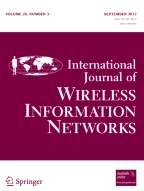Abstract
In this paper, we propose an extended reference model and two novel Sum-of-Sinusoids (SoS) models (statistical and deterministic simulation models) propagation models considering the Rician K-factor and vehicle speed ratio in Vehicular Ad Hoc Networks (VANETs). Our models consider comprehensive scene of wave propagation in VANETs, including infrastructure-to-vehicle (I2V) channels with a LOS or NLOS environment, inter-vehicle communication (IVC) channels with a LOS or NLOS environment. The analysis of the statistical properties of the proposed models show that the statistics of the new models match those of the reference model at a large range of normalized time delays. The proposed models show improved approximations to the desired auto-correlation and faster convergence with the increase of Rician K-factor and vehicle speed ratio.





Similar content being viewed by others
Explore related subjects
Discover the latest articles, news and stories from top researchers in related subjects.References
M. Boban, O. K. Tonguz, and J. Barros, Unicast communication in Vehicular Ad Hoc Networks: a reality check, IEEE Communications Letters, Vol. 13, No. 12, pp. 995–997, 2009.
A. F. Molisch, F. Tufvesson, J. Karedal, and C. F. Mecklenbrauker, A survey on vehicle-to-vehicle propagation channels, IEEE Transactions on Wireless Communications, Vol. 16, No. 6, pp. 12–22, 2009.
Z. Shen and J. P.Thomas, Security and QoS self-optimization in mobile ad hoc networks, IEEE Transactions on Mobile Computing, Vol. 7, No. 9, pp. 1138–1151, 2008.
T. Taleb, E. Sakhaee, A. Jamalipour, K. Hashimoto, N. Kato, and Y. Nemoto, A stable routing protocol to support ITS services in VANET networks, IEEE Transactions on Vehicular Technology, Vol. 56, No. 6, pp. 3337–3347, 2007.
W. J. Wang, F. Xie, and M. Chatterjee, Small-scale and large-scale routing in vehicular ad hoc networks, IEEE Transactions on Vehicular Technology, Vol. 58, No. 9, pp. 5200–5213, 2009.
H. Saleet, O. Basir, R. Langar, and R. Boutaba, Region-based location-service-management protocol for VANETs, IEEE Transactions on Vehicular Technology, Vol. 59, No. 2, pp. 917–931, 2010.
R. H. Clarke, A statistical theory of mobile-radio reception, Bell Systems Technical Journal, Vol. 47, No. 6, pp. 957–1000, 1968.
M. J. Gans, A power-spectral theory of propagation in the mobile-radio environment, IEEE Transactions on Vehicular Technology, Vol. 21, pp. 27–38, 1972.
P. Dent, G. E. Bottomley, and T. Croft, Jakes fading model revisited, IEEE Electronics Letters, Vol. 29, pp. 1162–1163, 1993.
M. F. Pop and N. C. Beaulieu, Limitations of sum-of-sinusoids fading channel simulators, IEEE Transactions on Communications, Vol. 49, pp. 699–708, 2001.
C. Xiao, Y. R. Zheng, and N. C. Beaulieu, Novel sum-of-sinusoids simulation models for Rayleigh and Rician fading channels, IEEE Transactions on Wireless Communications, Vol. 5, No. 12, pp. 3667–3679, 2006.
A. S. Akki and F. Haber, A statistical model for mobile-to-mobile land communication channel, IEEE Transactions on Vehicular Technology, Vol. 35, No. 1, pp. 2–7, 1986.
F. Vatalaro and A. Forcella, Doppler spectrum in mobile-to-mobile communications in the presence of three-dimensional multipath scattering, IEEE Transactions on Vehicular Technology, Vol. 46, No. 1, pp. 213–219, 1997.
R. Wang and D. Cox, Channel modeling for ad hoc mobile wireless networks, in Proceedings of IEEE Vehicular Technology Conference, May, 2002, Vol. 1, pp. 21–25.
D. J. Young and N. C. Beaulieu, The generation of correlated Rayleigh random variates by inverse discrete Fourier transform, IEEE Transactions on Communications, Vol. 48, no. 7, pp. 1114–1127, 2000.
C. S. Patel, S. L. Stuber, and T. G. Pratt, Simulation of Rayleigh faded mobile-to-mobile communication channels, IEEE Vehicular Technology Conference, Vol. 1, pp. 163–167, 2003.
C. S. Patel, G. L. Stuber, and T. G. Pratt, Simulation of Rayleigh-faded mobile-to-mobile communication channels, IEEE Transactions on Communications, Vol. 53, No. 11, pp. 1876–1884, 2005.
L. C. Wang, W. C. Liu, and Y. H. Cheng, Statisitical analysis of a mobile-to-mobile Rician fading channel model, IEEE Transactions on Vehicular Technology, Vol. 58, No. 1, pp. 32–38, 2009.
A. G. Zajic, and G. L. Stuber, A new simulation model for mobile-to-mobile rayleigh fading channels, IEEE Wireless Communication Networking Conference, (WCNC’06), Apr. 2006.
Acknowledgments
This work were supported by the National Natural Science Foundation of China (No. 60762005), the Natural Science Foundation of Jiangxi Province for Youth (No. 2010GQS0153 and No. 2009GQS0070) and the Graduate Student Innovation Foundation of Jiangxi Province (No. YC10A032).
Author information
Authors and Affiliations
Corresponding author
Appendix I
Appendix I
1.1 Proof of Correlation Auto-Function of the In-Phase Component of the Statistical SoS Model
Proof
we first prove the (19)
This completes the proof of (27). Similarly, one can prove the (28) and (29), details are omitted for brevity.
1.2 Proof of Variance of Auto-Correlation of the Complex Envelope
Proof
We start with the first equality of (22) and derive
Similarly, we can validate the second equality of (30) and (31). Thus, we have
This completes the proof.
Rights and permissions
About this article
Cite this article
Wang, Y., Xing, X. & Chen, S. Extended Sum-of-Sinusoids-Based Simulation for Rician Fading Channels in Vehicular Ad Hoc Networks. Int J Wireless Inf Networks 19, 147–157 (2012). https://doi.org/10.1007/s10776-011-0167-8
Received:
Accepted:
Published:
Issue Date:
DOI: https://doi.org/10.1007/s10776-011-0167-8

